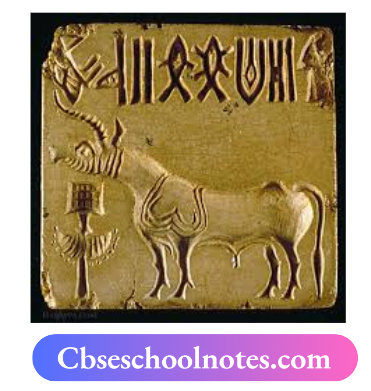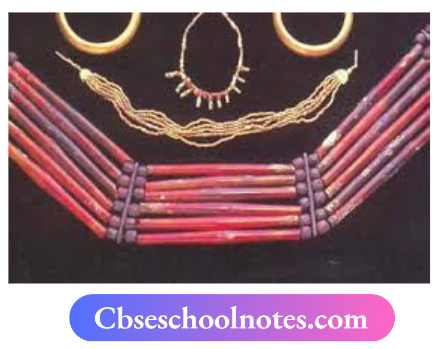CBSE Notes For Class 6 History Social Science Chapter 3 In The Earliest Cities
The Story Of Harappa
- About 150 years ago, when railway lines were being laid down for the first time in the Punjab, engineers encountered the site of Harappa (in present-day Pakistan).
- About 80 years ago, archaeologists found the site of Harappa and realized that it was one of the oldest cities in the sub-continent.
- Harappa was the first city to be discovered, thus all the other sites, where similar buildings (and other things) were found, were described as Harappan. These sites developed about 4700 years ago.
Harappan Cities
Many of the Harappan cities were divided into two or more parts as follows
Citadel It was the Western part of the city which was smaller but higher.
Lower Town It was the Eastern part of the city which was larger but lower.
- The strong walls of well-baked bricks were built around each part. The bricks were laid down in an interlocking pattern.
- In some cities, special buildings were constructed. For example, Great Bath in Mohenjodaro which was a special tank.
- It was built with bricks, coated with plaster, and made water-tight with a layer of natural tar. It had steps leading down to it from two sides and there were rooms on all sides.
- Water was probably brought in from a well, and drained out after use. On special occasions, important people of the city took a dip in the tank.
- The cities such as Kalibangan and Lothal had fire altars where sacrifices may have been performed. Some cities like Mohenjodaro, Harappa, and Lothal had elaborate storehouses.
Houses, Drains, and Streets: In the Harappan cities, the houses, drains, and streets were probably planned and built at the same time.
- The houses were either one or two storeys high with rooms built around a courtyard. Most of the houses had a separate bathing area and some had wells to supply water.
- The drains were covered in many cities and the inspection holes were provided at intervals to clean them.
- The drains were laid out in straight lines and each drain had a gentle slope so that water could flow through it.
- Mostly, the drains in houses were connected to the drains on the streets, and smaller drains led into bigger ones.
Class 6 History Social Science Chapter 3 Life in the City

- The people who constructed special buildings in the city were probably the rulers.
- The rulers probably sent people to distant lands to get metal, precious stones, and other valuable objects.
- They may have kept the most valuable objects, such as ornaments of gold and silver, or beautiful beads for themselves.
- The craftspersons (men and women) made all kinds of things, either in their homes or in special workshops, For Example. terracotta1 toys.
New Crafts in the City
- Most of the things found in Harappan cities by archaeologists were made of stones, shells, and metals including copper, bronze, gold, and silver.
- Copper and bronze were used to make tools, weapons, ornaments, and vessels. Gold and silver were used to make ornaments and vessels.
- Apart from these things, beads, weights, and blades are the most important things found by the archaeologists.
- Seals were also made with stone by the Harappans, which are generally rectangular and have an animal carved on them. They also made pots with beautiful black designs.

Cotton and Cloth
- Cotton was probably grown at Mehrgarh about 7000 years ago. From the site of Mohenjodaro, actual pieces of cloth were found attached to the lid of a silver vase and some copper objects.
- Archaeologists have also found spindle whorles, made of terracotta and faience, which were used to spin thread.
- Many of these things were made by the specialists. A specialist is a person (man or woman) who is trained to do only one kind of work. For example, cutting stones, polishing beads, or carving seals.
Raw Materials: Raw materials are those substances that are processed to produce finished goods. They are either found naturally (such as wood, or ores of metals) or produced by farmers or herders.
- Some of the raw materials used by the Harappans were locally available but many items such as copper, tin, gold, silver, and precious stones had to be brought from distant places.
- The Harappans probably got copper from present-day Rajasthan and Oman in West Asia. Tin which was mixed with copper to produce bronze, which may have been brought from present-day Afghanistan and Iran.
- Gold could have been brought from present-day Karnataka, and precious stones from present-day Gujarat, Iran, and Afghanistan.
Class 6 History Social Science Chapter 3 Food for People in the Cities
- The people living in the countryside grew crops and reared animals. These farmers and herders supplied food to craftspersons, scribes, and rulers in the cities.
- It was evident from the remains of plants that the Harappans grew wheat, barley, pulses, peas, rice, sesame, linseed, and mustard.
- A new tool, the plough³, was used to dig the Earth for turning the soil and planting seeds. Toy models of plows have been found in the cities.
- Some form of irrigation may have been used as these cities did not receive heavy rainfall. Water was stored and supplied to the fields when the plants were growing.
- Water and pastures’ were available around the settlements as the Harappans reared cattle, sheep, goats, and buffalo.
- During the summer months, large herds of animals were probably taken to greater distances in search of grass and Hnntppans collected fruits like her, caught fish, and hunted wild animals like the antelope.
Class 6 History Social Science Chapter 3 Harappan Towns in Gujarat
The Harappan towns of Dholavira and Lothal have been discovered in the state of Gujarat.
Dholavira: The city of Dholavira was located on Khadir Beyt in the Rann of Kutch, where there was fresh water and fertile soil.
- Dholavira was divided into three parts, and each part was surrounded by massive stone walls, with entrances through gateways. There was also a large open area in the settlement where public ceremonies could be held.
- In Dholavira large letters of Harappan script were found which were carved out of white stone and inlaid in wood.
- It is a unique find because Harappan writing has been generally found on small objects such as seals.
Lothal: The city of Lothal was located on the bank of a tributary of the Sabarmati river in Gujarat, close to the Gulf of Khambat.
- This site was an important center for making objects from stone, shell, and metal. Raw materials such as semi-precious stones were easily available here.
- There was also a storehouse in this city where many seals and sealings (the impression of seals on clay) were found.
- The pieces of stone, half-made beads, tools for bead making, and finished beads have been found here which suggests that there was a workshop for making beads in Lotha
Class 6 History Social Science Chapter 3 End of the Harappan Cities
- Around 3900 years ago, people stopped living in many of the cities, and the writing, seals, and weights were no longer used.
- The buying of raw materials from long distances was reduced. In Mohenjodaro garbage piled up, on the streets, the drainage system broke down and new houses were built, even over the streets.
The reasons suggested by some scholars for these changes were
- The rivers dried up and there was deforestation because a large quantity of fuel was required for baking bricks and for smelting5 copper ores. ;
- Grazing by large herds of cattle, sheep, and goats may have destroyed the green cover, while there were floods in some areas.
- However, these reasons do not explain the end of all the cities, because the flooding or drying of a river would have had an effect only in some areas. It appears that the rulers had lost control over the cities.
- The sites in Sind and West Punjab (present-day Pakistan) were abandoned, while many people moved into newer, smaller settlements to the East and the South. New cities emerged about 1400 years later
